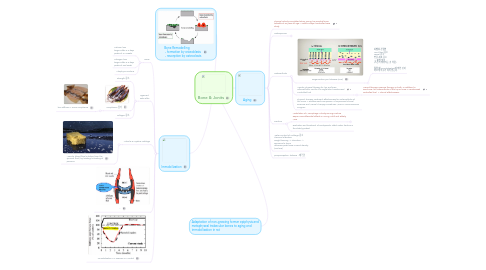
1. Bone Remodelling - formation by osteoblasts - resorption by osteoclasts
2. Immobilization
2.1. Bone
2.1.1. Calcium loss begins after 2-3 days peaks at 3-7 weeks
2.1.2. Nitrogen loss begins after 5-6 days peaks at 2nd week
2.1.3. Atrophy & Fracture
2.2. Ligament 2wks after
2.2.1. Strength 감소
2.2.2. compliance 증가
2.2.2.1. less stiffness = more compliance
2.2.3. collagen 감소
2.3. Articular & Hyaline cartilage
2.3.1. Vascular blood flow (nutrition from the synovial fluid ) by loading/unloading of pressure
2.4. ...
2.5. Immobilization v.s. exercise v.s. control
3. Adaptation of non-growing former epiphysis and metaphyseal trabecular bones to aging and immobilization in rat
4. Aging
4.1. Physical activity completed when young has residual bone benefits at 94 years of age: A within-subject controlled case study
4.2. Osteoporosis
4.2.1. Posture Training Support: Preliminary Report on a Series of Patients With Diminished Symptomatic Complications of Osteoporosis
4.3. Osteoarthritis
4.3.1. Degenerative joint disease (DJD)
4.3.1.1. 퇴행성 관절염 Joint fluid 감소 vessel 감소 연골 세포 감소 -> 파열 위험 (스폰지 찢겨지는 것 처럼) 젊을 때 immobilization에 의한 것과 다르게 복구가 되지 않는다.
4.3.2. Aquatic physical therapy for hip and knee osteoarthritis: results of a single-blind randomized controlled trial
4.3.2.1. Manual therapy, exercise therapy, or both, in addition to usual care, for osteoarthritis of the hip or knee: a randomized controlled trial. 1: clinical effectiveness.
4.3.3. Physical Therapy Treatment Effectiveness for Osteoarthritis of the Knee: A Randomized Comparison of Supervised Clinical Exercise and Manual Therapy Procedures Versus a Home Exercise Program
4.4. Fracture
4.4.1. Modulation of Macrophage Activity During Fracture Repair Has Differential Effects in Young Adult and Elderly Mice
4.4.1.1. Objectives: Advanced age is a factor associated with altered fracture healing. Delays in healing may increase the incidence of complications in the elderly, who are less able to tolerate long periods of immobilization and activity restrictions. This study sought to determine whether fracture repair could be enhanced in elderly animals by: (1) inhibiting macrophage activation, (2) blocking the M-CSF receptor c-fms, and (3) inhibiting monocyte trafficking using CC chemokine receptor-2 (CCR2) knockout mice. Methods: Closed unstable tibial shaft fractures were produced in mice aged 4, 12, and 78 weeks. Mice were then fed a diet containing PLX3397 or a control diet from days 1–10 after injury. Fractures were similarly made in CCR2-/- mice aged 78 weeks. The fracture callus was collected during fracture healing and was assessed for its size and the presence of macrophages, both of which were evaluated using the Mann–Whitney U test. Results: PLX3397 treatment resulted in a decrease in the number of macrophages in the fracture callus at day 5. Calluses in juvenile mice trended toward being smaller compared with those in elderly mice (P = 0.08). There was also a trend toward larger callus size and increased bone formation in PLX3397-treated elderly animals when compared with those of the control animals (P = 0.12). Similar increases in bone formation (P = 0.013) and decreases in cartilage within the callus (P = 0.03) were seen at day 10 in CCR2-/- mice. Conclusions: The inhibition of macrophages in elderly mice may lead to an acceleration of fracture healing. Altering macrophage activation after fracture may represent a therapeutic strategy for preventing delayed healing and nonunion in the elderly.
4.4.1.2. Community-based rehabilitation post hospital discharge interventions for older adults with cognitive impairment following a hip fracture: a systematic review protocol.
4.4.2. Evaluation and treatment of osetoporotic distal radius fracture in the elderly patient
